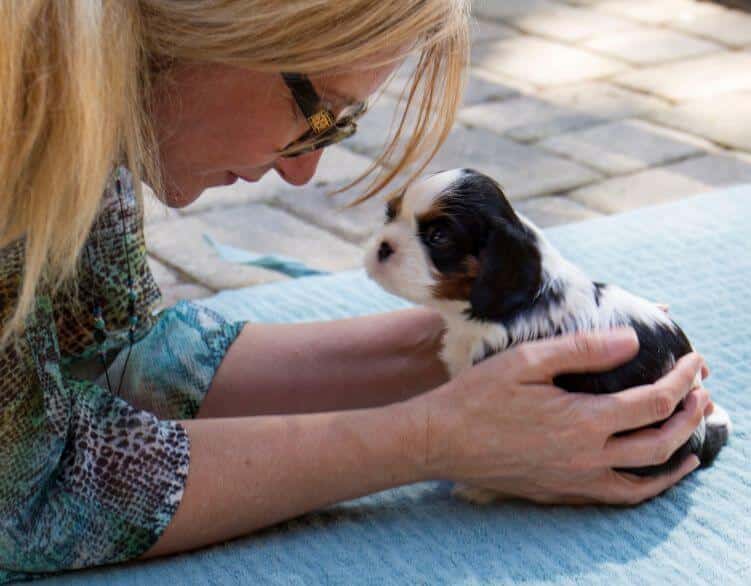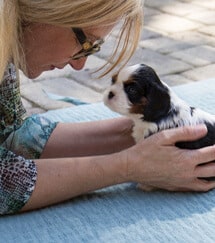Interview with a Toy Group Breeder Michele True
Where do I live? How many years in dogs? How many years as a breeder?
Michele True: I have been in dogs for 48 years, if you count being raised in a family where Golden Retrievers and Labradors were a beloved part of our home. At six, I assisted my father when our beloved yellow Labrador, “Sing,” whelped her first litter.
In 2014, my husband and I began researching Cavalier King Charles Spaniels and searching for breeders with integrity. Our first Cavalier, CH Boatswain Ciril, “Brunello,” was brought into our home as a pet. I had no intention of dedicating my life to preserving and showcasing Cavaliers (or any dogs) when he came to us.
However, Brunello’s endearing temperament and lovely conformation changed all of our plans. My husband and I joined regional AKC Cavalier King Charles Spaniel clubs, the CKCSC-USA, and Cavaliers of the South to learn more about the breed. It wasn’t long before we decided to carefully build the foundation of Evera True Cavalier King Charles Spaniels with healthy dogs and bitches that fit our vision of correct Cavaliers.
What is my kennel name? How many dogs do I currently keep?
Michele True: Evera True Cavalier King Charles Spaniels is our kennel name. If you don’t count our house-mouse English Toy Spaniel, “Tink,” or our beloved Irish Wolfhound house-moose, we have 15 Cavaliers in our program.
Which show dogs from the past have been my noteworthy winners?
Michele True: GCH Dual CH Legacy Chenin Blanc With Evera, “Miss Bliss,” is, by far, our most successful girl to date. Miss Bliss took the world by storm when she debuted in the CKCSC USA Cavaliers of the South show in Williamsburg, Virginia. She finished in one weekend. Afterward, she strutted her stuff with handler Patricia Martello in sanctioned AKC shows where she finished her championship and earned her grand championship in a handful of shows. Miss Bliss was the only Cavalier to make the cut last year at Westminster—without a professional handler. We’re very proud to announce that she will be competing at Westminster again this year alongside her brother, CH Legacy Blind Justice, “Romulus.”
Can I talk a bit about my facilities? Where are my puppies whelped? How are they raised?
Michele True: Our facilities are not, actually, facilities. Our boys and girls live in the house (kennels for the boys are on the opposite side of the house from the girls and puppy area) and are part of our daily lives. Outside playtime takes place in our professionally installed turf play zone—sectioned into space for age-appropriate play. Currently, our bitches in season have two areas for privacy and exercise at the opposite side of the yard. We are currently building a 1,300 sq. ft. home on our property for my kennel manager, Michele Bachmann. Specialized rooms for bitches in season and grooming are included in the house plans. We’re very much looking forward to our in-season girls having several acres between them and the dogs!
The nursery and whelping area are located in the master suite. I love having them close to me at all times, and this space gives the moms the privacy they need to raise pups in a stress-free environment. In our whelping area, we’ve organized an area for an Annie Box incubator from Sharon Macy, an oxygenator, sterile whelping tools, and a comfortable chair for the sleepless humans. From day three to eleven, we follow Early Neurological Stimulation protocol, followed by sensory exploration that includes seven surfaces in seven days, and sound desensitizing.
What is my “process” for selecting show puppies? At what age do I make my decisions?
Michele True: When puppies turn three weeks old, we move them and their mom into a 4×4 Midwest playpen with safely installed bedding and a dangling toy gym made for us by our friends, John and Laura Glynn. I love the 4×4, as it is large enough to include a decent-sized turf and potty tray that we potty train the pups on.
At eight weeks old, we assess our puppies for show/conformation potential as well as for puppies that show the intelligence and aptitude to be trained as therapy dogs. I look for structure; lovely lines, flat topline, correct tail-set, correct bite, and large, melting, double-pigmented eyes with no white to be found. If I’m lucky, I can get picky about fortunately placed markings. I typically pull in our handler and one or two mentors for input. When in doubt, we will run a puppy on for a year until we are confident in deciding to keep for show or place in a well-vetted pet home.
How do I prepare my pups for the show ring? Does my breed require any special preparation?
Michele True: Preparation for the show ring starts with the Early Neurological Stimulation. I am convinced that this easy protocol jump-starts a puppy’s confidence and ability to bond. Playtime that includes table work, getting puppies used to having their bite shown, and socializing them in a myriad of environments such as Home Depot and outdoor farmers’ markets are all a part of our routine. We like to make it fun for everyone. Grooming a Cavalier puppy for the ring is a pleasure. They are pretty much “wash and fluff.”
Grooming for conformation shows is an interesting topic of discussion—or non-discussion—these days. Our standard specifically states that “NO trimming of the dog is permitted.” However, it is permissible, and often desirable, to remove the hair growing between the pads on the underside of the foot. I’ve read old documents and club minutes, recording how the women and men in the United Kingdom organized to ensure our breed’s recognition in England. Their passion for preserving this “small, sporty dog” and that it should be “guarded from fashion,” as “the perfectly natural dog was desired, and was not to be spoilt to suit individual tastes, or as the saying goes, carved into shape,” was clear. That was over 100 years ago.
In my humble opinion (remember, I am a very new competitor and preservationist breeder) the majority of Cavalier King Charles Spaniels presented for conformation have been groomed to perfection, and one may see a Cavalier in the ring that has been slightly trimmed here and there so that it looks as though it hasn’t been trimmed, and you will see a Cavalier here and there that has clearly been “carved into shape.” The majority fall somewhere in-between. I, personally, am not offended by a beautifully groomed, sculpted, and whisker-free Cavalier King Charles Spaniel. I am more concerned with temperament, melting eyes and soft expression, and structure. The keepers of the Standard ultimately lie with our esteemed judges, and I have never seen or heard of a judge dismissing an exhibitor from the ring for over-grooming.
Are there any health-related concerns within my breed? Any special nutritional needs?
Michele True: I believe it’s important to state that I am a new breeder with less than ten years of experience, but I have dedicated hundreds of hours to researching the health and well-being of Cavalier King Charles Spaniels, talking with a large number of quality breeders with at least thirty years of experience, and researching pedigrees for health and longevity. We, as Cavalier breeders, are able to celebrate increased longevity as a breed due to a high number of preservationist breeders who have decades of knowledge that they apply and share with others freely. Dry eye, curly coat, and episodic falling have been nearly eliminated in quality kennels because of this. Mitral valve disease and syringomyelia are the two health concerns that we all continue to focus on. With mitral-valve disease, the science and medicine are available to make quantifiable improvements. As with most Toy Breeds, syringomyelia continues to be a condition that, in my opinion, needs more definitive scientific data for a complete and complex understanding of the condition. In the meantime, the conversation about the viability of MRI testing is hotly debated behind closed doors by intelligent, quality breeders of all breeds impacted by this condition. Discussing the health of any breed is a slippery slope because of the recent laws enacted in Norway. If the Norwegian lawsuits and judgements do not make breeders of every purebred dog nervous, they should. Misinformation about the studies conducted are being pushed by media sources in ways that threaten to destroy the future of purebred dogs. Breeders with the knowledge and experience to help alleviate these misconceptions are terrified to speak up or have their words put into print for fear they will be targeted by a number of organizations, from governmental to non-profit.
In my opinion, is my breed in good condition overall. Any trends that warrant concern?
Michele True: Yes! My beloved breed is in good condition overall, and getting better by the day. My main concern is that the popularity of the Cavalier King Charles Spaniel has seen a dramatic increase in popularity as a pet. Many times, people seeking a Cavalier as a pet get so impatient, they end up purchasing a puppy from a retail store or other questionable sources. I get phone calls and emails daily from people looking for a puppy. As I have very few litters a year, I take the time to direct these pet seekers to reputable breeders, to educate them on how to recognize puppy mills and backyard breeders, and to encourage them to reach out to respected
rescue organizations.
Do I feel that my breed is supported by a sufficient number of preservation breeders?
Michele True: Because of the trending popularity of our breed, I feel there is definitely room for more preservationist breeders. As a “greenhorn” in the Cavalier King Charles Spaniel world, I have found many fabulous mentors who have decades of experience and knowledge and are willing to share once they have had time to assess the reasons why I joined their ranks. I’m sure it is the same in any breed. Those breeders who have dedicated their lives to preserving a breed want and need to vet those of us who are new. Their legacy of passion and love for the breed is one they protect until they know that they are mentoring someone with the same passion, love, and dedication they started with—someone who has integrity and high values. Most importantly, we all want to see that making money is never a motivation for a newcomer. When money drives a breeding program, dangerous concessions are made and the breed, as a whole, suffers.
Is my breed well-suited to be a family dog? Who are the best candidates to own my breed?
Michele True: I am biased, of course, and think that the Cavalier King Charles Spaniel is the ultimate family pet. Their temperament is gentle, yet playful. They are able to bond with more than one person, which gives each person in the family a precious relationship with these lovely dogs. They are as active as their owners (I have a pet family that kayaks every weekend, with their Cavalier perched on the front of the kayak) or they can Netflix binge with the best of us. Cavaliers are happiest when they make each and every member of the family happy.
The best families for Cavalier ownership are those that are able to be with the dog at all times. I never consider placing a puppy with a family or individual who has to leave the dog alone for more than three hours at any time. This breed does not do well when left alone for long periods of time, and can become depressed and/or anxious if this happens.
I am biased, of course, and think that the Cavalier King Charles Spaniel is the ultimate family pet. Their temperament is gentle, yet playful. They are able to bond with more than one person, which gives each person in the family a precious relationship with these lovely dogs.
For a bit of fun, what’s the most amusing thing I’ve ever experienced with a Toy Dog?
Michele True: Our first Cavalier and AKC Champion, Boatswain Ciril, “Brunello,” loves puppies. He always has! When he was out with his handler, Hiram Stewart, we had conversations about how Brunello had taken to “mothering” his Pekinese puppies. Brunello continues to nanny each and every one of our puppies—taking time to groom them, play with them, help detour them from anything he considers unsafe, and curling up with them for naps. He also demands to be in the whelping room every time we whelp—even when he hasn’t sired the litter. Our mothers don’t mind at all, as he lies quietly next to their whelping bed in what we can only describe as support and protection. When we have no puppies in the house, which is often, he has two special “babies” that he totes around with him everywhere and arranges on his cushion at bedtime.









